Why is the Size of the Ground Conductor Smaller than the Line Conductor?
The ground wire does not always have to be the same size as the power (phase or hot) wire, but its size must comply with the requirements set by electrical codes, such as the National Electrical Code (NEC) in the United States. The specific size of the ground wire depends on the following factors.
Although rare, for long runs or circuits requiring reduced impedance, the ground wire may need to be upsized due to the voltage drop in the ground wire. It is to reduce the resistance of the grounding path, potentially matching the phase conductor’s size.
In certain installations, engineers may choose to size the ground wire equal to the phase wire for added safety, particularly in critical systems or in regions with stricter local codes.
When the Ground Wire Smaller than the Power Wire Size
The ground (or grounding) wire is often smaller than the phase (hot) and neutral wires in an electrical circuit for the following reasons:
- Phase Wire: Carries the full load current during normal operation.
Neutral Wire: Carries return current same as phase wire back to the source. - Ground Wire: Serves as a safety path for fault currents (e.g., short circuits or leakage) to protect equipment and personnel. It is not part of the normal current-carrying circuit.
Since the ground wire typically carries current only during faults, its size can be smaller than that of the phase wire, as it does not need to handle continuous load currents.
Fault currents flow for a very short duration, usually only until the overcurrent protection device (such as a circuit breaker or fuse) trips. Therefore, the ground wire is sized to handle these brief surges without overheating.
The ground wire is designed to handle fault currents long enough to allow protective devices to disconnect the circuit. Its smaller size is adequate because the fault duration is short, minimizing the risk of significant heat buildup.
A smaller ground wire reduces costs and material usage while still meeting safety and performance requirements. Over-sizing the ground wire would result in unnecessary expense without providing additional safety benefits.
Voltage drop is not a design concern for ground wires because they do not carry current continuously. In addition, the length of the ground wire are installed for short runs, hence, it will carry the fault ground quickly to the ground and trip the breaker without overheating the wire. This allows a smaller size without affecting the circuit’s performance.
Grounding Conductor Size per NEC
The National Electrical Code (NEC) provides a (Table 250.122) that specifies the minimum size of the equipment grounding conductor (EGC) based on the rating of the overcurrent protection device (circuit breaker or fuse) protecting the circuit.
Other electrical standards, such as the IEC, specify the minimum size for grounding conductors based on the size of the phase conductors and the maximum fault current expected. These guidelines ensure that the ground wire is neither too small (to prevent failure during faults) nor unnecessarily large.
Example:
-
- For a 15-amp breaker, The hot wire is #12 AWG and the ground wire must be at least #14 AWG copper.
- For a 20-amp breaker, The hot wire is #10 AWG and the ground wire must be at least #12 AWG copper.
- For a 50-amp breaker, The hot wire is #6 AWG and the ground wire must be at least #10 AWG copper.
- For a 100-amp breaker and panel, the service cable is #4 AWG and the ground wire must be at least #8 AWG copper.
- For a 200-amp service, the hot wires are at least #3/0 AWG and the ground should be #4AWG.
- For circuits with very large breakers (e.g., 600 amps), the ground wire must be sized accordingly.
This means that, in most cases, the ground wire is smaller than the phase wire, but there are exceptions.
When the Ground Wire Matches the Power Wire Size
There are situations where the ground wire must be the same size as the power wire, such as:
- Bonding Conductors: Ground wires used for bonding (e.g., connecting metal parts of equipment to the grounding system) may need to be the same size to handle fault currents effectively.
- Large Conductors: For circuits using large conductors (e.g., 3/0 or larger), the NEC requires proportionally larger ground wires.
- Special Equipment: Sensitive or high-capacity equipment such as PV installations may require ground wires sized the same as phase wires to ensure adequate fault current flow and reduce impedance.
What Happens if You Use Smaller or Larger Ground Wire?
The ground wire is not always the same size as the hot or neutral wires. It can be slightly larger or smaller than the other wires. Using a larger ground wire does not harm the system but increases the cost. If needed, you can extend the wire using a junction box.
A larger ground wire is safe to use and even beneficial in some cases. Larger wires have lower resistance, which reduces voltage drop. If your system requires higher current capacity, opting for a larger ground wire is a good choice.
On the other hand, using a ground wire that is too small can lead to problems. A smaller wire has higher resistance, which can hinder the breaker’s magnetic trip function. Additionally, smaller wires may fail to handle excessive current, leading to overheating, melting, or even fire hazards.
For ground connections, it is recommended to use a wire of adequate size. For example, in a typical 100-amp service with a distance of 150 feet, an 8 AWG (American Wire Gauge) ground wire is recommended. This ensures safety and proper system performance.
Good to Know:
The neutral wire must always be the same size as the hot wire to ensure proper current balance and safe operation. However, the ground wire can be smaller, as it primarily serves as a safety conductor rather than carrying the load current in normal conditions.
Resources:
- What is the Difference Between Neutral, Ground and Earth?
- Why is the Grounding Wire Bare and Not Insulated?
- Will I Get an Electric Shock If I Touch the Ground Wire?
- Will a Man Get an Electric Shock If He Hangs on a Live Wire?
- Can the Neutral Wire Cause Electric Shock? Different Cases
- How Does the Grounding System Work in Aircraft & Submarines?
- What Happens When You Touch an Electrical Busbar?
- What is the Right Wire Size for 15A Breaker and Outlet?
- What is the Suitable Wire Size for 20A Breaker and Outlet?
- How to Find the Right Wire Size for 100A Service 120V/240V Panel?
- How to Find the Proper Size of Wire & Cable In Metric & Imperial Systems
- Cable and Wire Size Calculator for Copper and Aluminum
- How to Measure Ground Resistance? Testing Earth Resistance
- Why is Copper Rod Used as Ground Rod in Grounding / Earthing System?
- Difference Between Grounding, Earthing and Bonding

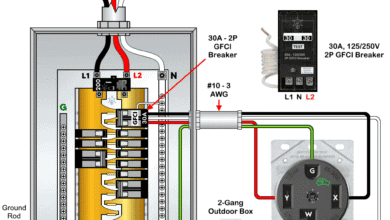 How to Wire a 30A, 125V/250V – NEMA 14-30 Receptacle
How to Wire a 30A, 125V/250V – NEMA 14-30 Receptacle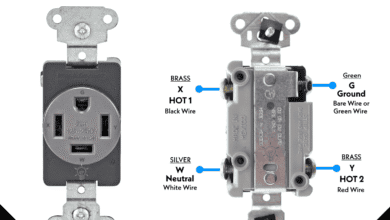 How to Wire a 20A, 125V/250V – NEMA 14-20 Receptacle
How to Wire a 20A, 125V/250V – NEMA 14-20 Receptacle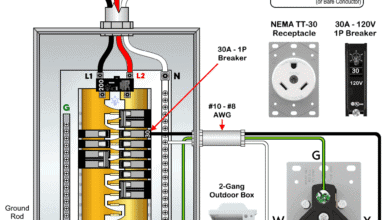 How to Wire NEMA TT-30 Receptacle for RVs & Travel Trailers
How to Wire NEMA TT-30 Receptacle for RVs & Travel Trailers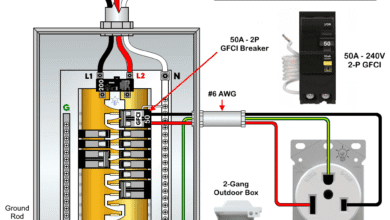 How to Wire a 50A – 250V, NEMA 6-50 Receptacle
How to Wire a 50A – 250V, NEMA 6-50 Receptacle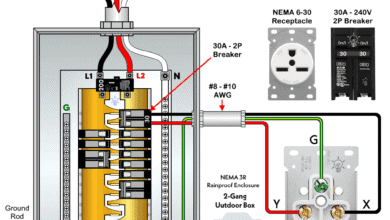 How to Wire a 30A – 250V, NEMA 6-30 Receptacle
How to Wire a 30A – 250V, NEMA 6-30 Receptacle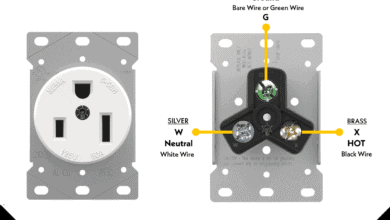 How to Wire a 50A – 125V – NEMA 5-50 Receptacle
How to Wire a 50A – 125V – NEMA 5-50 Receptacle